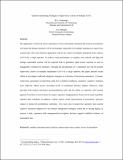| dc.contributor.author | Cummings, M. L. | |
| dc.contributor.author | Mitchell, P. J. | |
| dc.date.accessioned | 2014-09-23T20:55:56Z | |
| dc.date.available | 2014-09-23T20:55:56Z | |
| dc.date.issued | 2007 | |
| dc.identifier.uri | http://hdl.handle.net/1721.1/90289 | |
| dc.description.abstract | The application of network centric operations to time-constrained command and control environments
will mean that human operators will be increasingly responsible for multiple simultaneous supervisory
control tasks. One such futuristic application will be the control of multiple unmanned aerial vehicles
(UAVs) by a single operator. To achieve such performance in complex, time critical, and high risk
settings, automated systems will be required both to guarantee rapid system response as well as
manageable workload for operators. Through the development of a simulation test bed for human
supervisory control of multiple independent UAVs by a single operator, this paper presents recent
efforts to investigate workload mitigation strategies as a function of increasing automation. A humanin-
the-loop experiment revealed that under low workload conditions, operators’ cognitive strategies
were relatively robust across increasing levels of automated decision support. However, when
provided with explicit automated recommendations and with the ability to negotiate with external
agencies for delays in arrival times for targets, operators inappropriately fixated on the need to globally
optimize their schedules. In addition, without explicit visual representation of uncertainty, operators
tended to treated all probabilities uniformly. This study also revealed that operators that reached
cognitive saturation adapted two very distinct management strategies, which led to varying degrees of
success. Lastly, operators with management-by-exception decision support exhibited evidence of
automation bias. | en_US |
| dc.description.sponsorship | This research was sponsored by Boeing Phantom Works. | en_US |
| dc.publisher | Aerospace Science and Technology | en_US |
| dc.subject | multiple unmanned aerial vehicles | en_US |
| dc.subject | human supervisory control | en_US |
| dc.subject | levels of automation | en_US |
| dc.title | Operator Scheduling Strategies in Supervisory Control of Multiple UAVs | en_US |
| dc.type | Article | en_US |
| dc.identifier.citation | Cummings, M.L., & Mitchell, P.J., Operator Scheduling Strategies in Supervisory Control of Multiple UAVs, Aerospace Science and Technology, Vol. 11, p. 339–348, 2007. | en_US |
